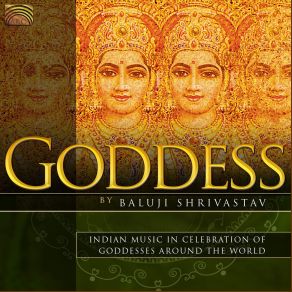Goddess: Indian Music in Celebration of Goddesses Around the World
Download links and information about Goddess: Indian Music in Celebration of Goddesses Around the World by Baluji Shrivastav. This album was released in 2010 and it belongs to World Music genres. It contains 7 tracks with total duration of 54:07 minutes.

|
|
|---|---|
| Artist: | Baluji Shrivastav |
| Release date: | 2010 |
| Genre: | World Music |
| Tracks: | 7 |
| Duration: | 54:07 |
| Buy it NOW at: | |
| Buy on iTunes $9.99 | |
Tracks
[Edit]| No. | Title | Length |
|---|---|---|
| 1. | 3 Goddesses (Parvati, Saraswati, Laxmi) [India] | 12:48 |
| 2. | Yemanja (Queen of the Ocean) [West Africa] | 9:39 |
| 3. | Dance of Erzulie (Goddess of Love) [Haiti] | 2:55 |
| 4. | Guan Yin (The Merciful) [China] | 5:58 |
| 5. | Amaterasu Omikami (Sun Goddess) [Japan] | 10:57 |
| 6. | Journey to Sedna (Inuit) | 4:43 |
| 7. | Hina in Moonlight (Haiti, Hawaii, Pacific Islands) | 7:07 |
Details
[Edit]Baluji Shrivastav is fast becoming something of a name in Indian classical music, based in large part on his recurring appearances throughout the U.K. and numerous recordings on ARC. Here, he takes an interesting idea — implementing the sitar in tandem with a number of other musical cultures in order to pay tribute to goddesses from Hinduism and beyond. The opening track, to the mother goddess Parvati, is straightforward sitar music, with a deep surbahar end reminiscent of Carnatic-influenced veena. An ode to the Yoruba Yemanja begins with a harp and ambient ocean sounds before moving into more traditional Indian fare. The Haitian Erzulie gets a much more tropical sound, with whistles and jangling percussion abundant but nary a stringed instrument to be heard. A piece to the Chinese Guan Yin includes pieces of the traditional silk and bamboo that so thoroughly marks a sound as Southern Chinese, but the zithers come out sounding nearly Persian or Turkish. Interesting, but it just barely makes musical sense. A tribute to Amaterasu works better, with the sitar mimicking shamisen and bass drums mimicking the roll of a taiko ensemble. The surbahar makes a new appearance in "Journey to Sedna," with a cowboy Western aesthetic to it, odd considering its Inuit basis. The album finishes on the Pacific Hina, which starts in the form of a Carnatic violin raga but adds in ethereal vocals that aren't quite of Indian or Pacific roots. This is something of a summary of the album in itself — Shrivastav does interesting things musically, but never quite breaks away from Indian classical formats (which indeed he shouldn't). At the same time, instead of incorporating the instruments or ideals of the other cultures' musics, he tends to find something else altogether different, creating an odd third stream in the process.